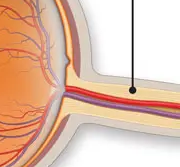The Optic Nerve: Physiology and Function
The optic nerve is a bundle of nerve fibers that carries visual information from the eye to the brain. It is an essential part of the visual system, and understanding its physiology is crucial for understanding vision and disorders that affect it. In this article, we will discuss the physiology and function of the optic nerve, as well as some common disorders that can affect it.
Physiology of the Optic Nerve
The optic nerve begins at the retina, the light-sensitive layer of tissue that lines the inner surface of the eye. The retina contains special cells called rods and cones, which convert light into electrical signals that are sent to the brain via the optic nerve. The electrical signals generated by the retina are called action potentials, which are generated by the ganglion cells in the retina. These action potentials travel along the optic nerve fibers to the brain, where they are interpreted as visual images.
The optic nerve fibers are divided into two main groups: the ganglion cells, which carry the visual signals from the retina to the brain, and the axons, which transmit the signals to the next nerve cell. The axons of the ganglion cells are wrapped in myelin, a fatty substance that insulates and protects the nerve fibers. This insulation allows the action potentials to travel quickly and efficiently along the optic nerve to the brain.
After leaving the eye, the optic nerve travels through the optic canal, a small opening in the skull, and into the brain. Once it reaches the brain, the optic nerve splits into two main branches: the optic tract and the optic radiation. The optic tract carries visual information from the eye to the primary visual cortex, which is located at the back of the brain. The optic radiation is responsible for transmitting information to other areas of the brain, such as the parietal and temporal lobes, which are involved in processing and interpreting visual information.
Function of the Optic Nerve
The main function of the optic nerve is to transmit visual information from the eye to the brain. The nerve fibers in the optic nerve carry electrical signals that are generated by the rods and cones in the retina. These signals are sent to the brain, where they are processed and interpreted as visual images.
The optic nerve also plays a role in regulating the size of the pupils and the intensity of the light that enters the eye. This is done through a reflex called the pupillary light reflex, which adjusts the size of the pupils in response to changes in light intensity. This reflex is mediated by the sympathetic and parasympathetic nervous systems, which control the size of the pupils.
Disorders of the Optic Nerve
There are several disorders that can affect the optic nerve and lead to vision loss. Some of the most common include:
- Glaucoma: This is a group of eye disorders that cause damage to the optic nerve. It is usually caused by increased pressure in the eye, which can lead to damage to the nerve fibers in the optic nerve.
- Optic neuritis: This is an inflammation of the optic nerve, which can lead to vision loss and other symptoms such as pain and redness in the eye.
- Trauma: Trauma to the eye or head can cause damage to the optic nerve, leading to vision loss.
- Optic neuropathy: This is a general term used to describe any disorder that affects the optic nerve and leads to vision loss.

Comments
Post a Comment